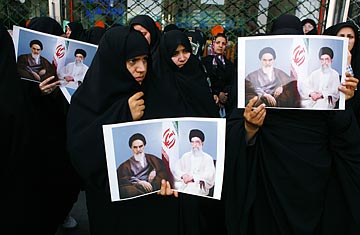
Thousands of people attend a state-organized rally in a square in central Tehran on June 16, 2009
(2 of 2)
According to Maloney, the election controversy provided considerable new insight into the cleric believed to hold absolute power, Ayatullah Ali Khamenei. Everyone expected voting irregularities, she said, but not "this degree of blatant, in-your-face fraud." That Khamenei almost instantly certified the victory of his candidate, incumbent President Mahmoud Ahmadinejad, dashed a central assumption about his regime: that its survival and social stability are intertwined with the legitimacy of Iran's democratic institutions. "He was willing to jettison the democratic institutions and effectively cede whatever remaining legitimacy there was in a popular vote in favor of maintaining total control," Maloney said.
Khamenei's abrupt dismissal of reform candidate Mir-Hossein Mousavi's supporters also suggests that he has lost touch with a central principle of the Islamic revolution, says Gary Sick, Jimmy Carter's top White House adviser on Iran during that period. Mousavi's supporters were mobilized by feelings of injustice, "that they've been dealt with contempt by their leaders," says Sick. "That sense of being wronged and betrayed is a driving feature in Iran," as powerful as the widespread anger over false arrest and torture by the Shah's secret police.
Before the postelection protests, Iranians were no longer thought to be willing to publicly vent their anger because of alienation from politics or fear of repression. Now they're taking to the streets in defiance of Khamenei and his paramilitary forces, setting up a potentially dangerous collision course. Firing on crowds could stretch the regime's legitimacy to the breaking point, creating a "crisis of confidence which I don't know how they'd resolve," says Geoffrey Kemp, a National Security Council adviser on Iran to Ronald Reagan.
For all its challenges to conventional wisdom, the uprising may be creating new misperceptions. The spotlight on young, English-speaking protesters in Western garb gives a false impression that they are typical of Iranians, says Ken Katzman, a Middle East specialist at the Congressional Research Service. "These symbols of the Iranian reform movement are quite visible, quite vocal and quite well endowed, technologically. But they're not a majority. We keep missing that." Rutgers University professor Hooshang Amirahmadi fears that policymakers will focus more on the election than on the larger struggle of a new class of secular nationalists to break the bonds of theocratic rule. "The movement is moving beyond the framework that the Islamic Republic has set for itself," Amirahmadi says. "It's no longer a struggle between factions in the system."
The recent surprising developments reaffirm the humbling nature of Iran analysis. But U.S. experts who are routinely forced to rethink their conclusions are in good company this time. "If Khamenei gets it wrong and doesn't really understand how the Iranian people are likely to see this, then we have some excuse for not always getting it right," says Sick.
